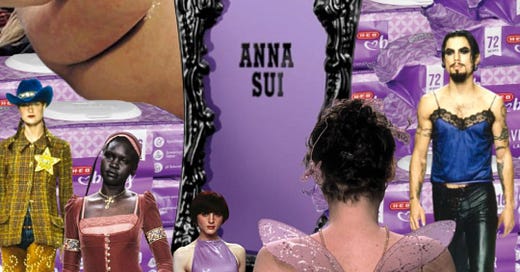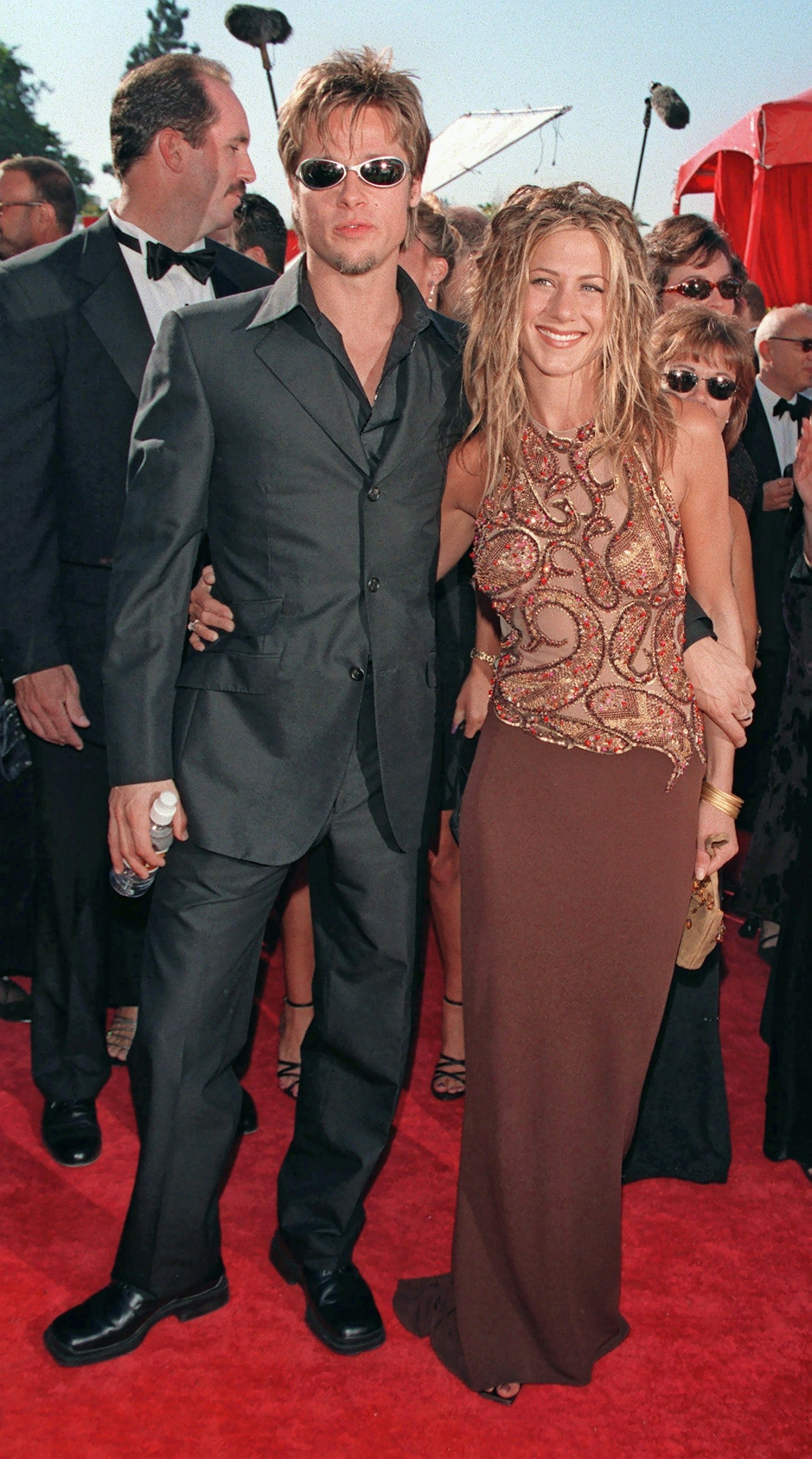On September 12, 1999, Jennifer Aniston and Brad Pitt walked the red carpet together for the 51st annual Primetime Emmy awards; their CAA agents had reportedly set them up six months prior (this is why I need representation), but this landmark LA evening marked the actors’ official coming out as a couple. Never had the world seen two people more famous, more beloved, or more tan posing together on a red carpet. Brad was photographed sans tie in a butterfly-collar dress shirt, roomy trousers, and Lisa Rinna-piecey highlights, while Jen was in a Randolph Duke gown with bearded paisley bodice, burgundy drop skirt, and the now infamous faux-dreadlock “rat nest.” Brad Pitt had just secured a $17 million payday for Fight Club and Jen was earning $25 million a year at NBC—together, they were arguably the powerful Hollywood couple in history.
Why did they look so completely busted?
Short answer: the late 90s marked an era of 1970s nostalgia and everyone looked fucked up. In January 1999 Amy Spindler wrote for The Times: “The slavishness with which so many so-called designers have reproduced the past is no longer predictable, it's laughable. Fashion for the last five years has been been the equivalent of Gus Van Sant's “Psycho:” a little more color than the original, perhaps, but the same old reasons to scream.” There was a collective obsession with anything retro but execution was sloppy, in part, because culture was still ephemeral— when a TV show was dropped from syndication it was literally gone forever, without a streaming lifecycle or internet archive. Couture collections were memorialized in magazines that were discarded in the literal trash. People craved nostalgia, but source material was difficult to come by, so stylists and designers took aesthetic liberties. The results were half-baked references pulled from memory, and as a tween I craved the flavor of these reheated nachos.
Brad’s Emmy suit came from Tom Ford’s SS ‘99 collection inspired by “Las Vegas hippies." This thrift-store aesthetic was reinforced by Brad-Pitt-as-Tyler-Durden in Fight Club and later satirized with Zoolander’s “Derelicte.” This + Patricia Field’s drunk preschooler styling on Sex and the City begged the question: did people actually want to look bad? These looks trickled down from Bryant Park, to Hollywood, to primetime, and finally, to the Del Amo Mall, my 12 year-old house of worship.
In 1999, I split my allowance between T.J. Maxx and a store called RAMPAGE that sold going-out-tops to tweens. With a wardrobe of department store discards and iridescent slip dresses, I needed a bargain bin perfume to match my freak and had $20 burning a hole in my pocket. Enter: Anna Sui by Anna Sui.
Fashion-wise, Anna Sui’s Salvation Army Victoriana signature fell somewhere between goth and grunge, a spectrum that encompassed anything remotely marketable in the late 1990s. In a 1997 moment of cultural Inception that threatened to bend the space-time continuum, her team enlisted Neo-funk 70s throwback rocker Dave Navarro to walk her ready-to-wear show of 70s throwback fashions. I was the target audience at the time and this simulacrum felt as real as the stuff in the history books. Anna Sui’s eponymous perfume was an extension of a larger commercial universe— a schematized xerox of a xerox of a xerox for those of us who weren’t yet around for the real thing.
In 1994, A Steven Meisel-directed ad campaign made Calvin Klein cool again, and the subsequent success of CK One proved that perfume could sell the aura of SoHo to Middle America. With this in mind, Anna Sui went a step further and debuted her fragrance as part of a larger cosmetics release licensed to Isetan, a Japanese Department store retailer. The decision brought Anna Sui name recognition to tweenage and teenage girls (like me), who clamored for her princess purple eyeshadow palettes displayed alongside Hard Candy nail polish at Macys. The decision was uniquely fitting because Anna Sui perfume actually smells like makeup— think cheap pressed powder and aerosol hairspray.
When I picked up my first bottle of Anna Sui at T.J. Maxx I didn’t give a fuck what it smelled like: the juice was violet and the bottle looked exactly like a black lacquered mirror my dad bought for me at pottery barn kids. I wore it with abandon for 6 years, alternating sprays with Gap Grass and, later, Marc Jacobs Original (the gardenia one). I bought these perfumes for their curb appeal and they’ve long since been discontinued, then rereleased, and later reformulated in attempts to appeal to a target demographic I’ve aged out of. While Gap Grass and Marc Jacobs finally seem to be gone for good, Anna Sui Classic is suddenly available again on Fragrancenet, and for less than I paid in 1999. It’s a comforting scent that hasn’t changed a bit: predictable, generic, and totally unmemorable. Perfect 💜





